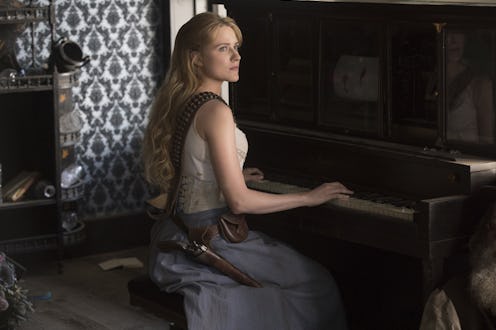Entertainment
A Huge 'Westworld' Cliffhanger Teases A Chaotic Second Half To Season 2

Spoilers ahead for Westworld Season 2, Episode 6. The sophomore season of HBO's sci-fi/Western series has passed its halfway point, and officially dropped its first major bombshell, in the sixth episode, "Phase Space." Is Ford still alive on Westworld? The park's creator, who was last seen getting gunned down by Dolores in the Season 1 finale, popped up again in a gasp-inducing cliffhanger to end the hour. But how?
The answer to his apparent immortality lies in two main concepts introduced in Season 2: the copying of human consciousness into host bodies, and "the Cradle." The season's fourth episode, "The Riddle Of The Sphinx," confirmed that Delos had secretly been working on prolonging human life by essentially cloning them as hosts. In that same episode, Bernard was seen in a flashback printing and then pocketing a "pearl" containing a copy of a human mind — and ever since, fans have been busy trying to predict which human character was coded into that little red ball.
Some viewers thought Ford must have ordered Bernard to print a copy of his own consciousness before he "sacrificed" himself; others thought that the pearl contained Arnold's mind, to be uploaded into Bernard's body and bring the park's co-creator finally and fully back to life; still others subscribed to more bizarre theories, like the idea that the pearl was William's dead wife Juliet, resurrected to haunt the Man In Black as part of Ford's "game."
It turns out that the most popular theory was also the correct one: the pearl contained a copy of Ford's own mind, printed by Bernard in preparation for his coup de grâce, to ensure that he would live on after a self-aware Dolores put a bullet in his brain. If this sounds like a cop-out to backtrack on a major character's death, keep in mind a couple of things.
First of all, to answer the initial question I posed: no, Ford is not still alive… at least, not in the traditional sense. His pearl was not placed inside a flesh-and-blood host body, but rather uploaded into the Cradle. Since his consciousness only exists inside a computer, and not inside a manufactured clone version of himself, it cannot really be said that he's "still alive" in the way that he was before. But his mind does live on in digital code.
Second of all, this is actually a fitting new chapter in Ford's story, rather than a cheap cop-out. In the Season 1 finale, shortly before the killing of his corporeal form, Ford gave a speech that turned out to be a moving eulogy to himself. "An old friend once told me something that gave me great comfort," he said to the assembled Delos board. "He said that Mozart, Beethoven, and Chopin never died. They simply became music." In essence, that is exactly what Ford has now done: he has become a part of his own creation. His consciousness is now inseparable from his code.
Ford now exists everywhere and nowhere at once, able to thwart QA's forces from within the Cradle by blocking their every attempt to reprogram his malfunctioning hosts and his new, rebellious narrative. And thanks to the fact that the Cradle from within appears as a perfect simulation of Westworld, it means viewers get Sir Anthony Hopkins back in the flesh as well, after all the prevaricating the writers did to assure fans the Oscar-winning actor was done with Westworld for good.
Before they get too busy celebrating Hopkins' return, viewers should remember one very important thing: "cognitive plateau." In the flashbacks with young William and the many attempted copies of Jim Delos, it was revealed that human consciousnesses copied into a pearl only last so long before plateauing… and then degrading with alarming results. Did Ford perfect that technology before he uploaded himself into the Cradle? Or are things in the park about to get even worse when the literal ghost in the machine starts to break down and go insane?